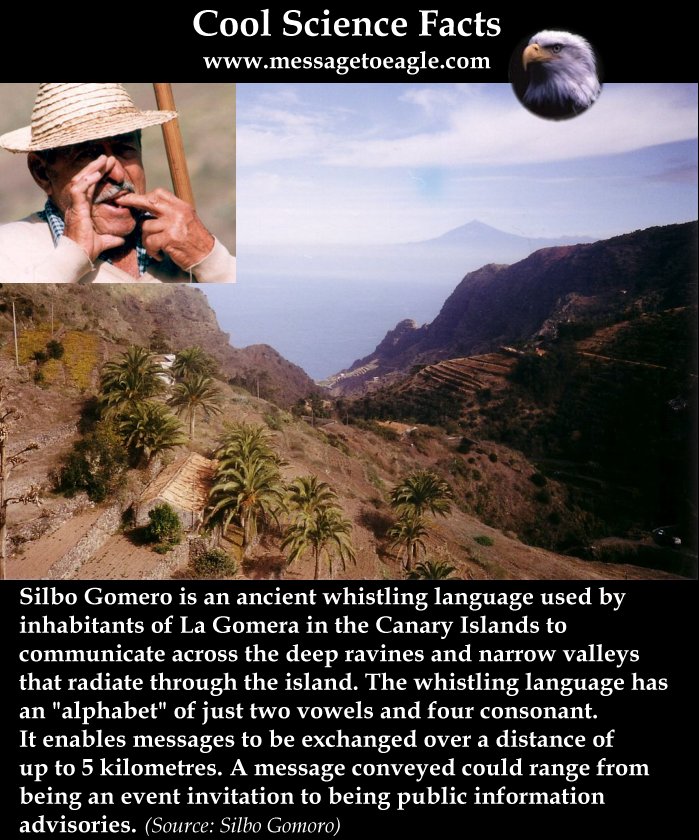Silbo Gomero: Whistling Language Used On The Canary Islands
Question: What is the Silbo Gomero language?
Answer: Silbo Gomero is an ancient whistling language used by inhabitants of La Gomera in the Canary Islands to communicate across the deep ravines and narrow valleys that radiate through the island. The whistling language has an “alphabet” of just two vowels and four consonant, so it’s very simple. It enables messages to be exchanged over a distance of up to 5 kilometres.
A message conveyed could range from being an event invitation to being public information advisories. There are no certainties about its origins. It is known that when the first European settlers arrived at La Gomera in the 15th Century, the inhabitants of the island – of North African origin – communicated with whistles. These whistles reproduced the indigenous language. With the arrival of the Spanish, the locals adapted the whistling language to Spanish.
The most likely theory is that the whistle came with the settlers from Africa, where there are records of other whistled languages.
See also: Kuuk Thaayorre Language Uses Cardinal-Direction To Define Space
The modern language is a variation of the one used by the indigenous Africans who once populated the islands.
All the people living in La Gomera know the language. Those born before 1950 were taught the language by their elders in their homes and those who have attended or are attending school since 1999 were taught the language formally in school.
The Silbo Gomero has been passed on, from one generation to another, as an element of the community’s intangible heritage.
MessageToEagle.com
Source:
Related Posts
-
 Illapa: Powerfull Master Of Clouds, Rain And Hail – Worshipped By Inca People
No Comments | Jul 7, 2016
Illapa: Powerfull Master Of Clouds, Rain And Hail – Worshipped By Inca People
No Comments | Jul 7, 2016 -
 Incredible Roseau Stone Reveals 200,000-Year-Old Writing
No Comments | May 26, 2014
Incredible Roseau Stone Reveals 200,000-Year-Old Writing
No Comments | May 26, 2014 -
 Mysterious Grave Of King Valdemar IV Atterdag – Will The 600-Year-Old Historical Puzzle Ever Be Solved?
No Comments | Nov 18, 2016
Mysterious Grave Of King Valdemar IV Atterdag – Will The 600-Year-Old Historical Puzzle Ever Be Solved?
No Comments | Nov 18, 2016 -
 Incredible Giant Shoebill Stork Looks Like A Real Dinosaur
No Comments | Sep 29, 2018
Incredible Giant Shoebill Stork Looks Like A Real Dinosaur
No Comments | Sep 29, 2018 -
 Gallic Leader Vercingetorix In Victorious Battle Of Gergovia, 52 BC
No Comments | Jan 23, 2017
Gallic Leader Vercingetorix In Victorious Battle Of Gergovia, 52 BC
No Comments | Jan 23, 2017 -
 Can You Be Allergic To Sunlight?
No Comments | Jul 4, 2017
Can You Be Allergic To Sunlight?
No Comments | Jul 4, 2017 -
 Size Of “Small” Rosetta’s Comet Compared To Los Angeles
No Comments | Feb 6, 2017
Size Of “Small” Rosetta’s Comet Compared To Los Angeles
No Comments | Feb 6, 2017 -
 Kudurru Of Melishihu – Stone Records From The Kassite Dynasty In Babylonia
No Comments | Jan 17, 2016
Kudurru Of Melishihu – Stone Records From The Kassite Dynasty In Babylonia
No Comments | Jan 17, 2016 -
 Is The Ancient Oarfish Legend Warning Of Coming Earthquakes True?
No Comments | Feb 28, 2017
Is The Ancient Oarfish Legend Warning Of Coming Earthquakes True?
No Comments | Feb 28, 2017 -
 Legend Of Brigadoon: Mythical Village Where Time Stands Still
No Comments | Nov 2, 2016
Legend Of Brigadoon: Mythical Village Where Time Stands Still
No Comments | Nov 2, 2016

